Deck 15: Nervous System
Question
Question
Question
Question
Question
Question
Question
Question
Question
Question
Question
Question
Question
Question
Question
Question
Question
Question
Question
Question
Question
Question
Question
Question
Question
Question
Question
Question
Question
Question

Unlock Deck
Sign up to unlock the cards in this deck!
Unlock Deck
Unlock Deck
1/30
Play
Full screen (f)
Deck 15: Nervous System
1
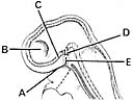 ________ Floor of the diencephalon
________ Floor of the diencephalonA)A
B)B
C)C
D)D
E)E
C
The floor of the diencephalon gives rise to the infundibulum (the primordium of the neurohypophysis)and the mammillary bodies.The infundibulum gives rise to the median eminence,the infundibular stem,and the pars nervosa.The infundibulum initially has a thin wall,but its distal end soon becomes thickened as the neuroepithelial cells proliferate.These cells later differentiate into pituicytes.
The floor of the diencephalon gives rise to the infundibulum (the primordium of the neurohypophysis)and the mammillary bodies.The infundibulum gives rise to the median eminence,the infundibular stem,and the pars nervosa.The infundibulum initially has a thin wall,but its distal end soon becomes thickened as the neuroepithelial cells proliferate.These cells later differentiate into pituicytes.
2
________ Gracile nuclei
A)Neural crest cells
B)Alar plates
C)Basal plates
D)Neuroepithelium
E)Spinal ganglion cells
A)Neural crest cells
B)Alar plates
C)Basal plates
D)Neuroepithelium
E)Spinal ganglion cells
B
The gracile and cuneate nuclei develop from neuroblasts that migrate from the alar plates into the marginal zone of the myelencephalon.These nuclei are associated with correspondingly named tracts that enter the medulla from the spinal cord.
The gracile and cuneate nuclei develop from neuroblasts that migrate from the alar plates into the marginal zone of the myelencephalon.These nuclei are associated with correspondingly named tracts that enter the medulla from the spinal cord.
3
 ________ Third ventricle
________ Third ventricleA)A
B)B
C)C
D)D
E)E
D
The third ventricle is formed mainly from the cavity of the diencephalon.The anterior part of the third ventricle is derived from the cavity of the telencephalon.
The third ventricle is formed mainly from the cavity of the diencephalon.The anterior part of the third ventricle is derived from the cavity of the telencephalon.
4
 ________ Lentiform nucleus
________ Lentiform nucleusA)A
B)B
C)C
D)D
E)E

Unlock Deck
Unlock for access to all 30 flashcards in this deck.
Unlock Deck
k this deck
5
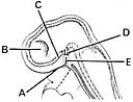 ________ Primordium of adenohypophysis
________ Primordium of adenohypophysisA)A
B)B
C)C
D)D
E)E

Unlock Deck
Unlock for access to all 30 flashcards in this deck.
Unlock Deck
k this deck
6
 ________ Infundibulum
________ InfundibulumA)A
B)B
C)C
D)D
E)E

Unlock Deck
Unlock for access to all 30 flashcards in this deck.
Unlock Deck
k this deck
7
 ________ Roof of primordial mouth cavity
________ Roof of primordial mouth cavityA)A
B)B
C)C
D)D
E)E

Unlock Deck
Unlock for access to all 30 flashcards in this deck.
Unlock Deck
k this deck
8
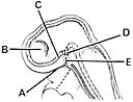 ________ Gives rise to the pars nervosa
________ Gives rise to the pars nervosaA)A
B)B
C)C
D)D
E)E

Unlock Deck
Unlock for access to all 30 flashcards in this deck.
Unlock Deck
k this deck
9
 ________ Hypothalamus
________ HypothalamusA)A
B)B
C)C
D)D
E)E

Unlock Deck
Unlock for access to all 30 flashcards in this deck.
Unlock Deck
k this deck
10
 ________ Internal capsule
________ Internal capsuleA)A
B)B
C)C
D)D
E)E

Unlock Deck
Unlock for access to all 30 flashcards in this deck.
Unlock Deck
k this deck
11
 ________ Produces cerebrospinal fluid (CSF)
________ Produces cerebrospinal fluid (CSF)A)A
B)B
C)C
D)D
E)E

Unlock Deck
Unlock for access to all 30 flashcards in this deck.
Unlock Deck
k this deck
12
________ Form ventral gray columns
A)Neural crest cells
B)Alar plates
C)Basal plates
D)Neuroepithelium
E)Spinal ganglion cells
A)Neural crest cells
B)Alar plates
C)Basal plates
D)Neuroepithelium
E)Spinal ganglion cells

Unlock Deck
Unlock for access to all 30 flashcards in this deck.
Unlock Deck
k this deck
13
________ Unipolar afferent neurons
A)Neural crest cells
B)Alar plates
C)Basal plates
D)Neuroepithelium
E)Spinal ganglion cells
A)Neural crest cells
B)Alar plates
C)Basal plates
D)Neuroepithelium
E)Spinal ganglion cells

Unlock Deck
Unlock for access to all 30 flashcards in this deck.
Unlock Deck
k this deck
14
________ Olivary nuclei
A)Telencephalon
B)Diencephalon
C)Mesencephalon
D)Metencephalon
E)Myelencephalon
A)Telencephalon
B)Diencephalon
C)Mesencephalon
D)Metencephalon
E)Myelencephalon

Unlock Deck
Unlock for access to all 30 flashcards in this deck.
Unlock Deck
k this deck
15
 ________ Invagination of pia mater
________ Invagination of pia materA)A
B)B
C)C
D)D
E)E

Unlock Deck
Unlock for access to all 30 flashcards in this deck.
Unlock Deck
k this deck
16
 ________ Primordium of the cerebral hemisphere
________ Primordium of the cerebral hemisphereA)A
B)B
C)C
D)D
E)E

Unlock Deck
Unlock for access to all 30 flashcards in this deck.
Unlock Deck
k this deck
17
________ Neuroglia
A)Neural crest cells
B)Alar plates
C)Basal plates
D)Neuroepithelium
E)Spinal ganglion cells
A)Neural crest cells
B)Alar plates
C)Basal plates
D)Neuroepithelium
E)Spinal ganglion cells

Unlock Deck
Unlock for access to all 30 flashcards in this deck.
Unlock Deck
k this deck
18
________ Sympathetic ganglion cells
A)Neural crest cells
B)Alar plates
C)Basal plates
D)Neuroepithelium
E)Spinal ganglion cells
A)Neural crest cells
B)Alar plates
C)Basal plates
D)Neuroepithelium
E)Spinal ganglion cells

Unlock Deck
Unlock for access to all 30 flashcards in this deck.
Unlock Deck
k this deck
19
________ Efferent function
A)Neural crest cells
B)Alar plates
C)Basal plates
D)Neuroepithelium
E)Spinal ganglion cells
A)Neural crest cells
B)Alar plates
C)Basal plates
D)Neuroepithelium
E)Spinal ganglion cells

Unlock Deck
Unlock for access to all 30 flashcards in this deck.
Unlock Deck
k this deck
20
________ Pons
A)Telencephalon
B)Diencephalon
C)Mesencephalon
D)Metencephalon
E)Myelencephalon
A)Telencephalon
B)Diencephalon
C)Mesencephalon
D)Metencephalon
E)Myelencephalon

Unlock Deck
Unlock for access to all 30 flashcards in this deck.
Unlock Deck
k this deck
21
 ________ Neurohypophysial bud
________ Neurohypophysial budA)A
B)B
C)C
D)D
E)E

Unlock Deck
Unlock for access to all 30 flashcards in this deck.
Unlock Deck
k this deck
22
________ Red nuclei
A)Telencephalon
B)Diencephalon
C)Mesencephalon
D)Metencephalon
E)Myelencephalon
A)Telencephalon
B)Diencephalon
C)Mesencephalon
D)Metencephalon
E)Myelencephalon

Unlock Deck
Unlock for access to all 30 flashcards in this deck.
Unlock Deck
k this deck
23
________ Cerebellum
A)Telencephalon
B)Diencephalon
C)Mesencephalon
D)Metencephalon
E)Myelencephalon
A)Telencephalon
B)Diencephalon
C)Mesencephalon
D)Metencephalon
E)Myelencephalon

Unlock Deck
Unlock for access to all 30 flashcards in this deck.
Unlock Deck
k this deck
24
________ Corpus striatum
A)Telencephalon
B)Diencephalon
C)Mesencephalon
D)Metencephalon
E)Myelencephalon
A)Telencephalon
B)Diencephalon
C)Mesencephalon
D)Metencephalon
E)Myelencephalon

Unlock Deck
Unlock for access to all 30 flashcards in this deck.
Unlock Deck
k this deck
25
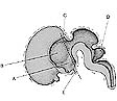 ________ Includes the mammillary bodies
________ Includes the mammillary bodiesA)A
B)B
C)C
D)D
E)E

Unlock Deck
Unlock for access to all 30 flashcards in this deck.
Unlock Deck
k this deck
26
________ Thalamus
A)Telencephalon
B)Diencephalon
C)Mesencephalon
D)Metencephalon
E)Myelencephalon
A)Telencephalon
B)Diencephalon
C)Mesencephalon
D)Metencephalon
E)Myelencephalon

Unlock Deck
Unlock for access to all 30 flashcards in this deck.
Unlock Deck
k this deck
27
 ________ Gives rise to the neurohypophysis
________ Gives rise to the neurohypophysisA)A
B)B
C)C
D)D
E)E

Unlock Deck
Unlock for access to all 30 flashcards in this deck.
Unlock Deck
k this deck
28
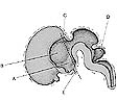 ________ Develops from the metencephalon
________ Develops from the metencephalonA)A
B)B
C)C
D)D
E)E

Unlock Deck
Unlock for access to all 30 flashcards in this deck.
Unlock Deck
k this deck
29
 ________ Forms the pineal gland
________ Forms the pineal glandA)A
B)B
C)C
D)D
E)E

Unlock Deck
Unlock for access to all 30 flashcards in this deck.
Unlock Deck
k this deck
30
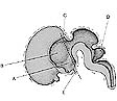 ________ Forms the thalamus
________ Forms the thalamusA)A
B)B
C)C
D)D
E)E

Unlock Deck
Unlock for access to all 30 flashcards in this deck.
Unlock Deck
k this deck



